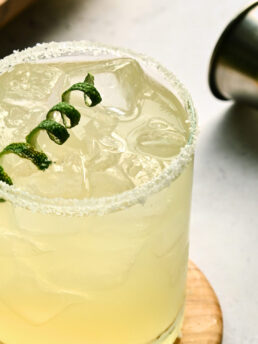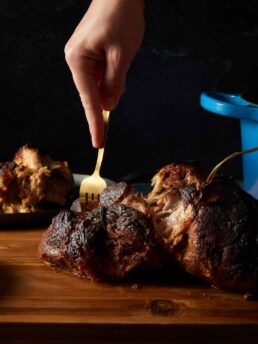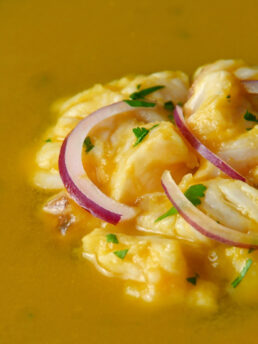The Rainwater: A Mezcal, Madeira, and Citrus Cocktail
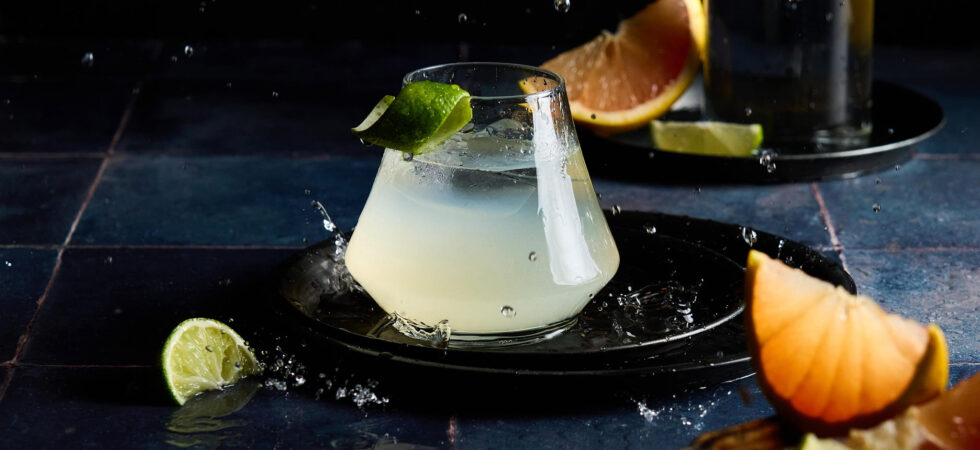
This is my copycat recipe for the Rainwater, a cocktail from El Cocinero Tacos y Tequila. It’s made with mezcal, Rainwater Madeira, grapefruit and lime juices, and falernum syrup for a delightfully balanced and layered beverage.
When it went off menu a few years ago I was le sad. But, then I pulled up my big girl panties and tinkered and tinkered until I had my beloved cocktail back. Now, I can share it with you!
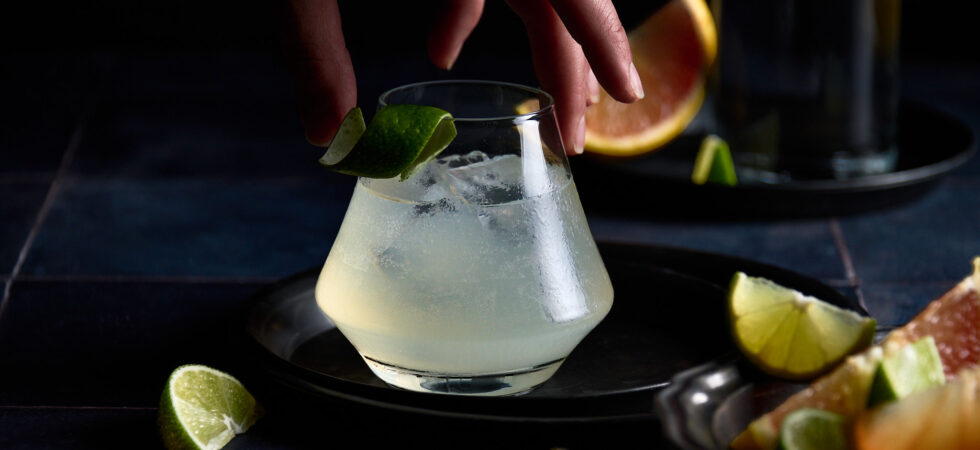
Get the Recipe: The Rainwater: A Mezcal, Madeira, and Citrus Cocktail
Ingredients
- 2 oz grapefruit juice, fresh squeezed
- ½ oz lime juice, fresh squeezed
- 1½ oz Del Maguey Vida Clásico Mezcal
- ½ oz Broadbent Rainwater Madeira
- 1 oz JDT's Velvet Falernum Liqueur
- 2-3 dashes Scrappy's grapefruit bitters
Equipment
- cutting board
- paring knife
- y-peeler optional
- citrus press/juicer optional
- liquid measuring cup or jigger
- cocktail shaker
- Hawthorne Strainer
- Fine Mesh Strainer
- coupe or rocks glass
Instructions
- First squeeze and measure out the fresh juice. If you plan to garnish the cocktail with lime peel, make sure to remove a large strip of the peel before cutting and juicing. Wrap the peel around a straw or something thin and round to set while you work on the rest of the drink.
- Next, measure out the rest of the ingredients and then add everything to a shaker. Top with ice, close the shaker, and vigorously shake everything for about 30 seconds.
- Double strain using a hawthorne strainer and a fine mesh strainer into either a chilled coupe glass (sans ice) or a chilled rocks glass (with a large ice cube/or medium cubes). Garnish with the twisted peel, if you made one.
Notes
- To batch this cocktail, multiply the ingredient quantities accordingly. Keep in mind that two things: 1. Freshness is key when it comes to citrus juices, so it’s best to pre-mix the other ingredients and then squeeze and mix in the juice just before serving to ensure optimal flavors. 2. Add a little water to the mix to represent ice melting during shaking the cocktail.
- You can also garnish this cocktail with a grapefruit or lime wedge.
Nutrition
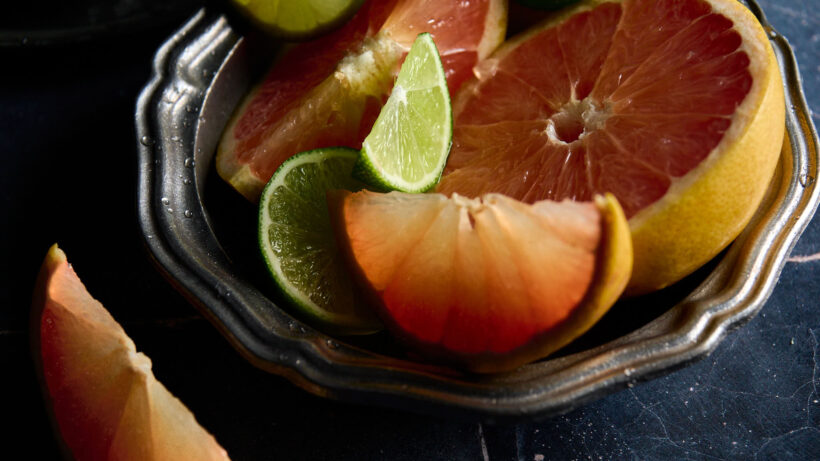
Frequently Asked Questions
2 reasons that basically do the same thing:
1. It takes the pulp out of the juice and 2. it removes tiny ice chips from your drink that will slip through just the hawthorne strainer. Both of these give the cocktail a smooth texture and uniform temperature.
If you don’t mind the initial texture of the ice chips, feel free to strain the juice after you squeeze it but before you add it into the mix.
But, I wouldn’t skip straining the juice. While some like pulp, it can throw off the balance of flavors in your cocktail when extra lime or grapefruit hits their tastebuds. Pulp in great in your morning OJ, but not the best in your handcrafted cocktail.
Like tequila, Mezcal is a spirit derived from agave. All tequilas are mezcal but not all mezcals are tequila. Kind of like how Champagne works, tequila is produced in a designated region of Mexico. It’s also made specifically from Blue Weber agave, while mezcal can be made with dozens of varietals of agave. Most mezcals are made from Espadín agave, but you might also see mezcals made with Tobalá, Tepextate, Arroqueño, Madrecuixe, Cuixe, and Jabalí. The reason Espadín is so widely used, is because it only takes 8 years, 1/2 to 1/3 of the time it can take for other varietals to fully mature.
The piñas (the heart of the agave plant) are harvested then roasted in underground pits or above-ground ovens to convert the starches into fermentable sugars. After roasting, the piñas are crushed, fermented, and distilled in clay pots for a traditional mezcal or in copper tanks for a more modern mezcal.
Just like wine, Mezcal flavors change based on several things:
-The varietal of agave;
-The terroir in which the agave was grown; and
-How the piñas are roasted and processed.
Vida clásico is made from Espadín agave. It has a nose of tropical fruit, honey, and roasted agave, while the palate offers ginger, cinnamon, and tangerine. When considering other mezcals to substitute for this cocktail, look for some of those flavors. Mezcals with citrus and tropical flavors are going to be the best to use. I think some vegetal notes in a mezcal choice could also work very well.
Rainwater Madeira is a style of fortified wine that originates from the Portuguese island of Madeira. It is named “Rainwater” due to a historical story that suggests casks of Madeira were left out in the rain, resulting in a lighter and fresher style of wine.
Rainwater Madeira is produced from a blend of different grape varieties, predominantly Tinta Negra Mole, which is the most widely cultivated grape on the island. The grapes are harvested, pressed, and fermented. The fermentation process is halted by the addition of brandy or other neutral grain spirits to fortify the wine. This fortification process raises the alcohol content and preserves the wine’s sweetness.
Unlike other Madeira styles, Rainwater Madeira tends to be lighter and less sweet. It is known for its medium-dry to medium-sweet taste profile. The wine typically exhibits notes of caramel, nuts, dried fruits, and sometimes a touch of citrus.
Broadbent Rainwater Madeira, the Madeira I chose for this recipe, has a nose of dried dates, figs, and orange peel. On the palate is fresh citrus and caramel flavors with a nice level of acidity. Notice how it complements the mezcal’s flavors.
There are other brands of Rainwater Madeira, so I’d first look there. See if you can find something that also has some citrus notes in it. If that’s not an option, there are some amaros that could work and brandy (cognac) could take the place of madeira as well. The only issue here is that those can be far sweeter than Rainwater Madeira, so you will most likely need to lessen the amount of falernum to your own tastes.
Velvet Falernum Liqueur is a sweet syrup with added rum to make an 11% ABV liqueur. It has flavors of lime, almond, ginger, and other warming spices. And, it’s a great way to add a tropical and aromatic touch to cocktails.
The next time a cocktail recipe uses simple syrup, consider switching it out for Falernum syrup. Falernum is a sweeter than a simple syrup, and about the viscosity of a rich simple syrup (2:1 sugar to water), so use that note accordingly when tinkering.
There are other Falernum syrups, some of which are alcohol free. They all have similar tastes, so it won’t be the end of the world if you decide to use a different one than listed in this recipe.
If you can’t find any falernum syrup in your local liquor store, no worries. You can easily find it online or you can actually make falernum syrup from scratch if you really want to get hardcore.
Bitters are made from taking a high-proof spirit and adding fruit, spices and/or botanicals until they infuse into the liquor. Think of bitters the way you think of spices in cooking. They are not solid, main ingredients. But, they can still shape the flavor to an overall dish or in this case beverage.
I use grapefruit bitters in this cocktail to bring that more forward. However you can also use lemon, lime, hibiscus, and orange bitters to keep that citrus note. Runners up include bitters with spice or ginger.

